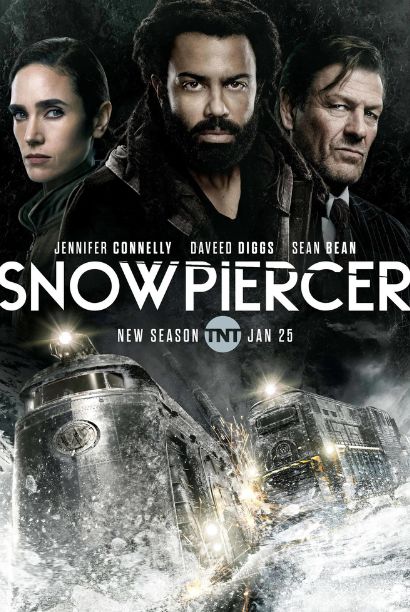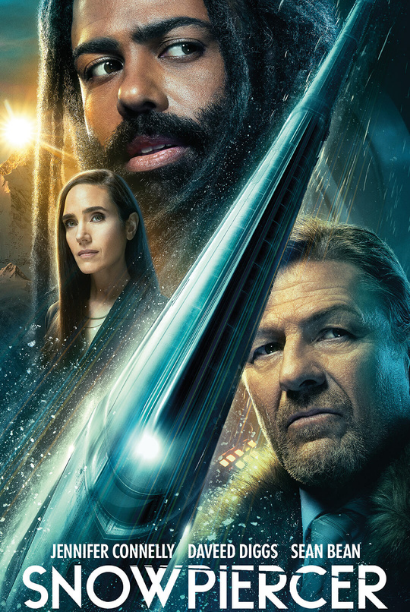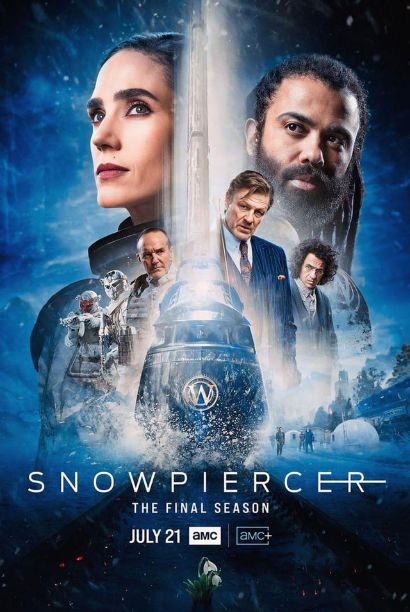Snowpiercer Case Study
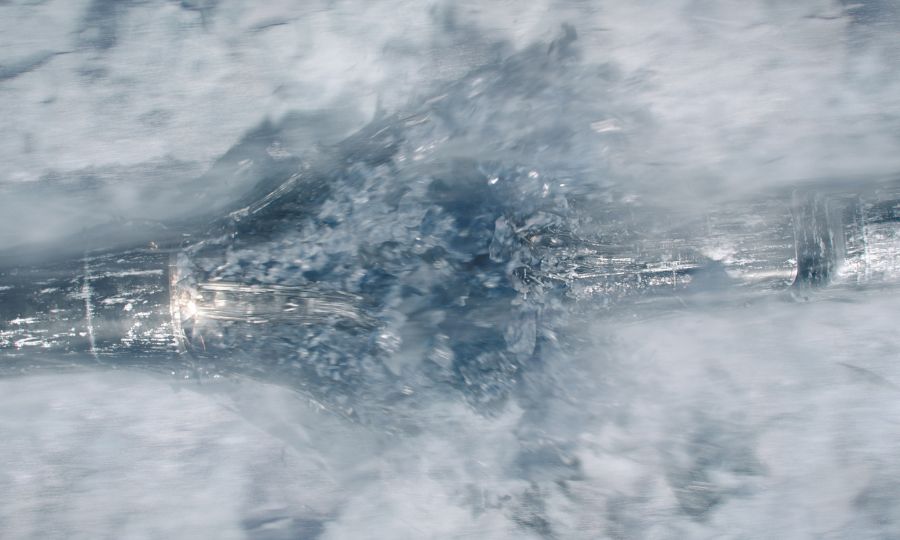
Case Study
Unveiling the art and science behind the visuals of Snowpiercer. Discover how Image Engine's creative synergy with the Snowpiercer production team brought the show’s icy world to life over the course of three seasons.
A journey on ice: Image Engine’s visual effects evolution on Snowpiercer
The critically acclaimed series, Snowpiercer, introduces audiences to a dystopian future Earth, where a cataclysmic climate event has rendered the planet a barren, frozen wasteland. Humanity’s remnants hurtle through a frozen wasteland on the Snowpiercer train that ceaselessly traverses the icy landscape. The train is strictly divided by class, with the affluent living in luxury towards the front and the less fortunate crammed into the tail end. Throughout the series, these societal frictions, coupled with the constant threat of the inhospitable environment, form the basis of a story that intertwines drama, action, and a struggle for justice.
Jump to:
Creating such a world on screen is no easy task, and Image Engine has been a force as perpetual and constant as Snowpiercer itself in developing the series’ aesthetics over seasons two, three, and four. Over the seasons, the Image Engine has combined dystopian aesthetics and elaborate visual effects to create an engaging world, whether that meant generating the desolate beauty of Snowpiercer‘s icy external world or designing the intricate, mechanical complexity of the eponymous train.
“On season 2, we initially started with just a handful of exterior train shots, mostly full CG or using some plate elements,” begins VFX Supervisor Hannes Poser, who details Image Engine’s initial involvement and subsequent growth on the show. “Over time, we established Image Engine as the main vendor for Snowpiercer and worked on most of the big visual effects shots and FX-heavy sequences. Our work started to include complex combinations of multiple plate elements, expansive environments, and some tricky FX. It’s been quite the journey!”
And that work has not gone unnoticed. Image Engine’s contributions to Snowpiercer received a nomination in the 2022 Emmys for ‘Outstanding Special Visual Effects In A Single Episode’ for season three’s A Beacon For Us All.
“Being nominated for an Emmy was an amazing experience for the whole team,” says Hannes. “Snowpiercer is a challenging show for visual effects vendors, as the episodic release and timeframe are strict. So to finish the tremendous amount of work at the high-quality standard the client and we at Image Engine expect, all in a relatively short time frame, is an enormous accomplishment. To be considered among the best visual effects work of 2022 was simply amazing.
“From day one on Snowpiercer, everyone at Image Engine went above and beyond expectations. The team did extraordinary work, so I’m excited to acknowledge everything the team did and how their efforts only got more impressive as we went from season to season.”
Embarking on a frosty journey
Image Engine boarded the Snowpiercer saga halfway through season two, which was released in 2021. Season two reveals that humanity’s remnants weren’t confined solely to Snowpiercer – another train, Big Alice, had survived, commanded by the enigmatic Mr. Wilford, the original creator of Snowpiercer. With the plot’s increased complexity and escalating tension, Image Engine’s role in creating believable, immersive visuals was crucial.
The series’ centrepiece, the Snowpiercer train itself, posed a monumental task in its own right.
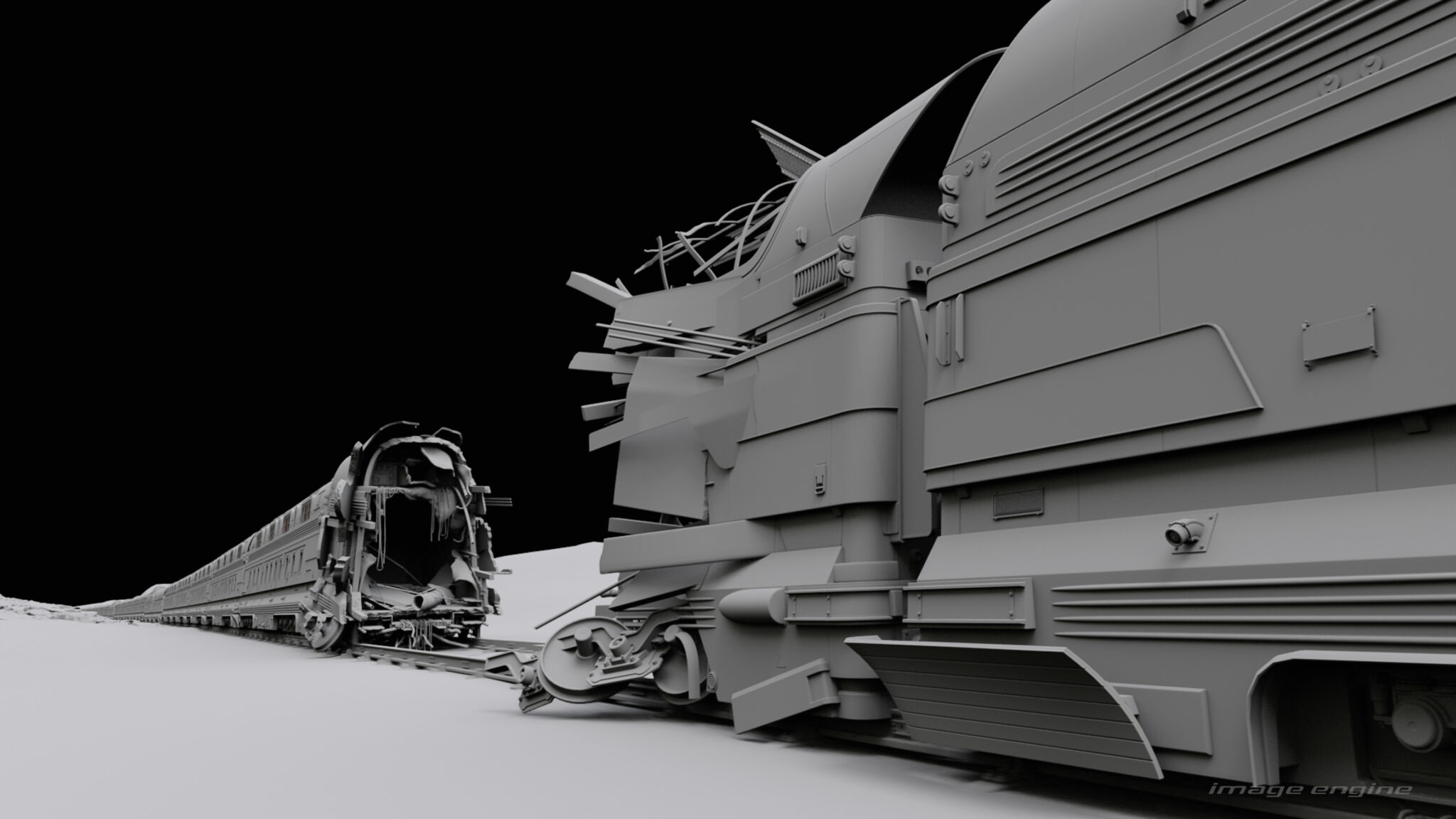
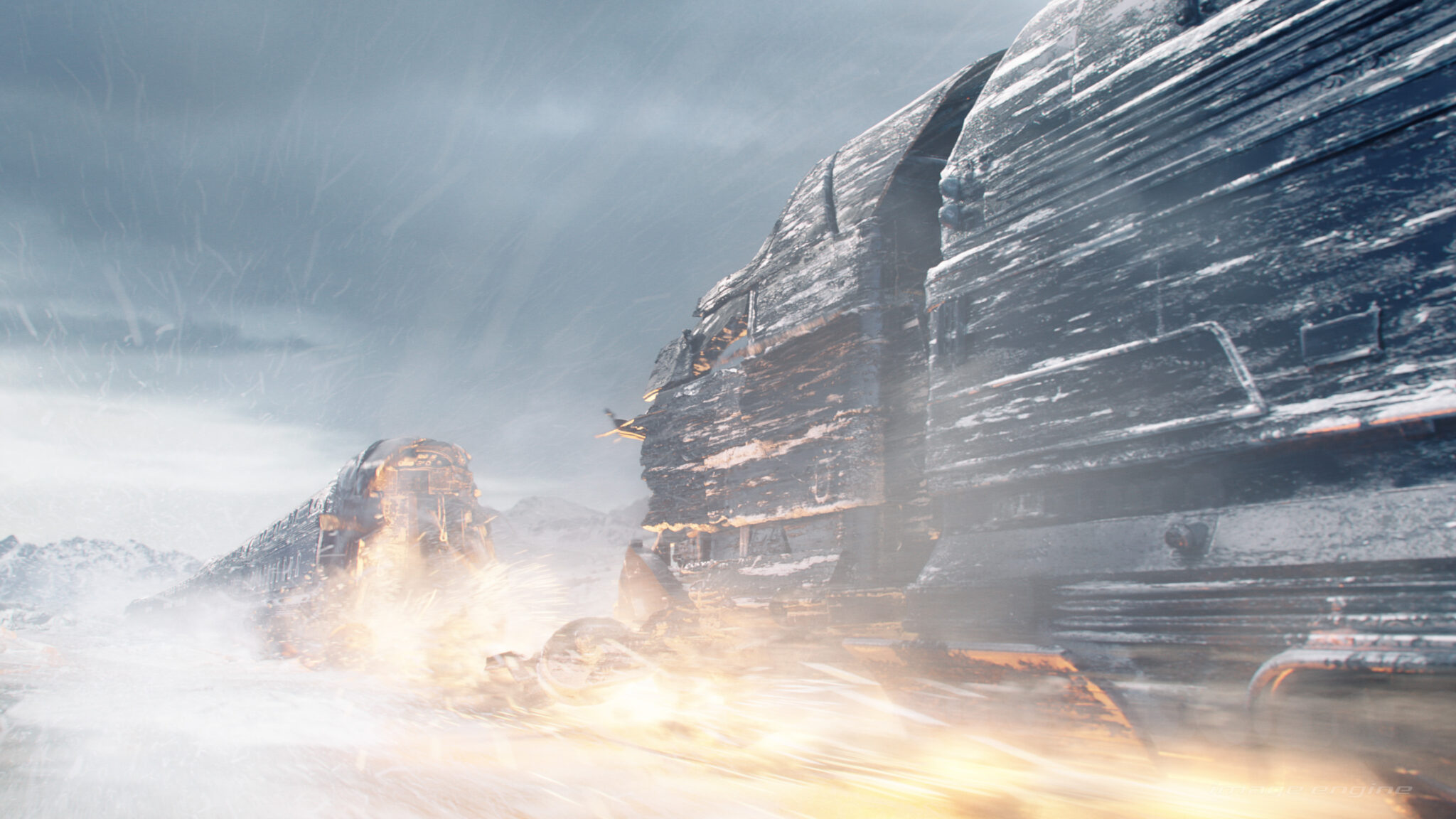
“The Snowpiercer train is 10 miles and 1,001 cars long,” says Hannes. “Depending on the story, we see different parts of the train in every episode as the train gets split and rearranged. Throughout working on Snowpiercer, we added and changed many things about the train, like optimizing the assets, adding interiors, instancing identical parts like the wheel assembly, and more. Some episodes might mean we would have to add interiors or details because the camera gets close to an area only ever seen from afar or from inside, like the train’s roof, its undercarriage, the aquarium car, the J-links between trains, the observatory bubble, the crane car, the vent intake, the rocket car, and the snow treads added in season four. We were constantly building and adding things to this train to build out the story of Snowpiercer. It may sound trite, but even from season two, the train really was a character and a constant in Snowpiercer. We worked hard to give it the attention it deserved.”

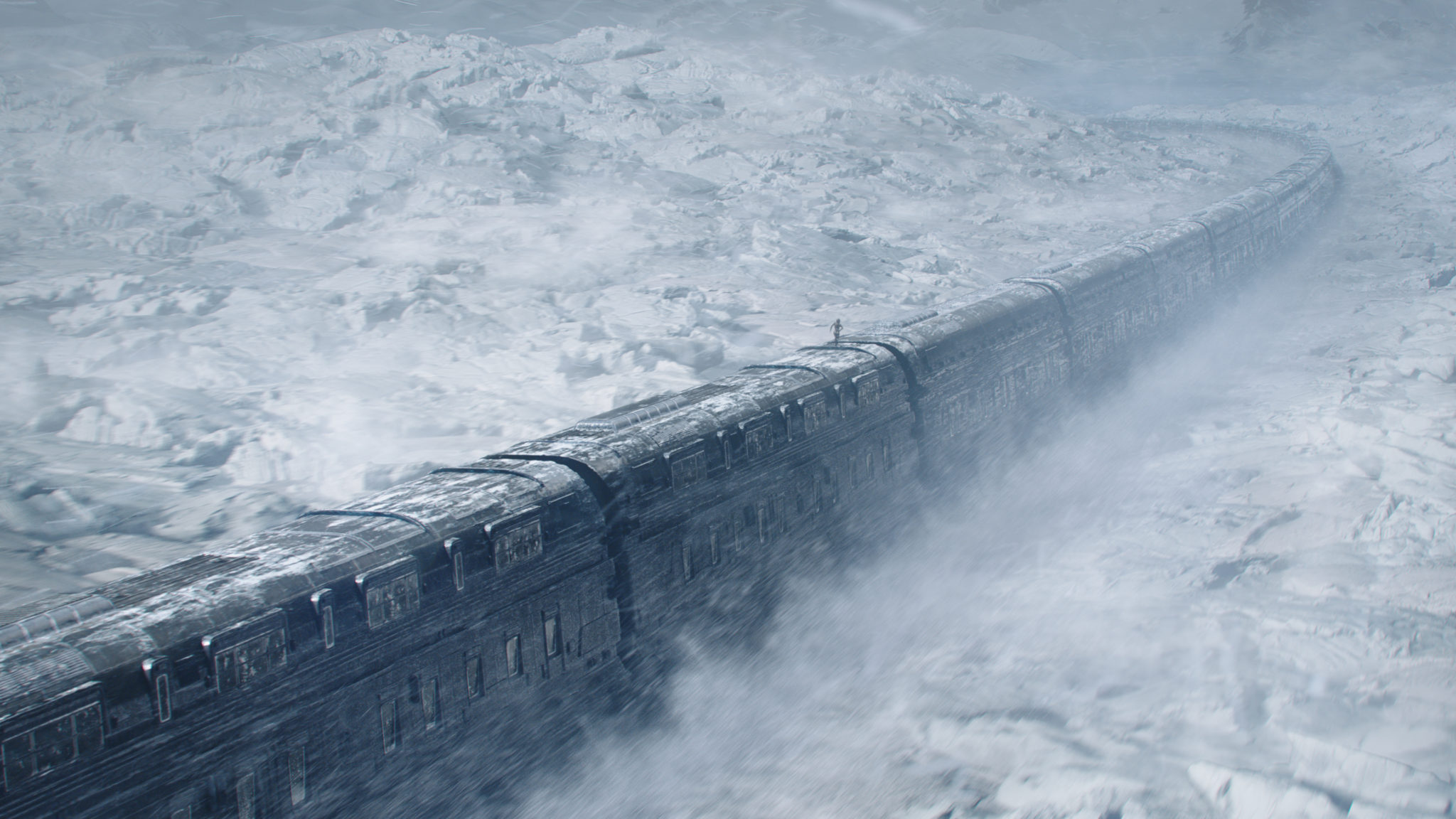
Image Engine’s mid-season entry to season two and the tight deadlines across the show meant the team needed to find innovative ways to make work on the Snowpiercer train happen quickly. For instance, Hannes promptly recognized the need for a tool to animate the train and adjust the track effectively.
“We started developing and adding features based on need, such as creating a curve-based ‘train track tool’ to place and move connected train cars on a track in layout,” says Hannes. “We could easily update the train track tool based on notes and client feedback. For example, we might have to swap cars, change the curvature of the track, adjust ground height and shape – there was a lot we needed to do quickly and without disrupting workflow. The train track tool allowed us to do that. It was pretty basic in season two but grew with every season in capability and effectiveness.
Another challenge was that we had to create a lot of detailed environments but there was not always enough time to create all of them before we had to deliver layouts. So our layout team had control over the general landscape and placed mountains, canyons or ridges as a guide for the asset team. We would then uprez that proxy geometrie after layout approval. This allowed us to stay more flexible with changes to the camera placement and speed of the train or curvature and slope of the track during layout.”
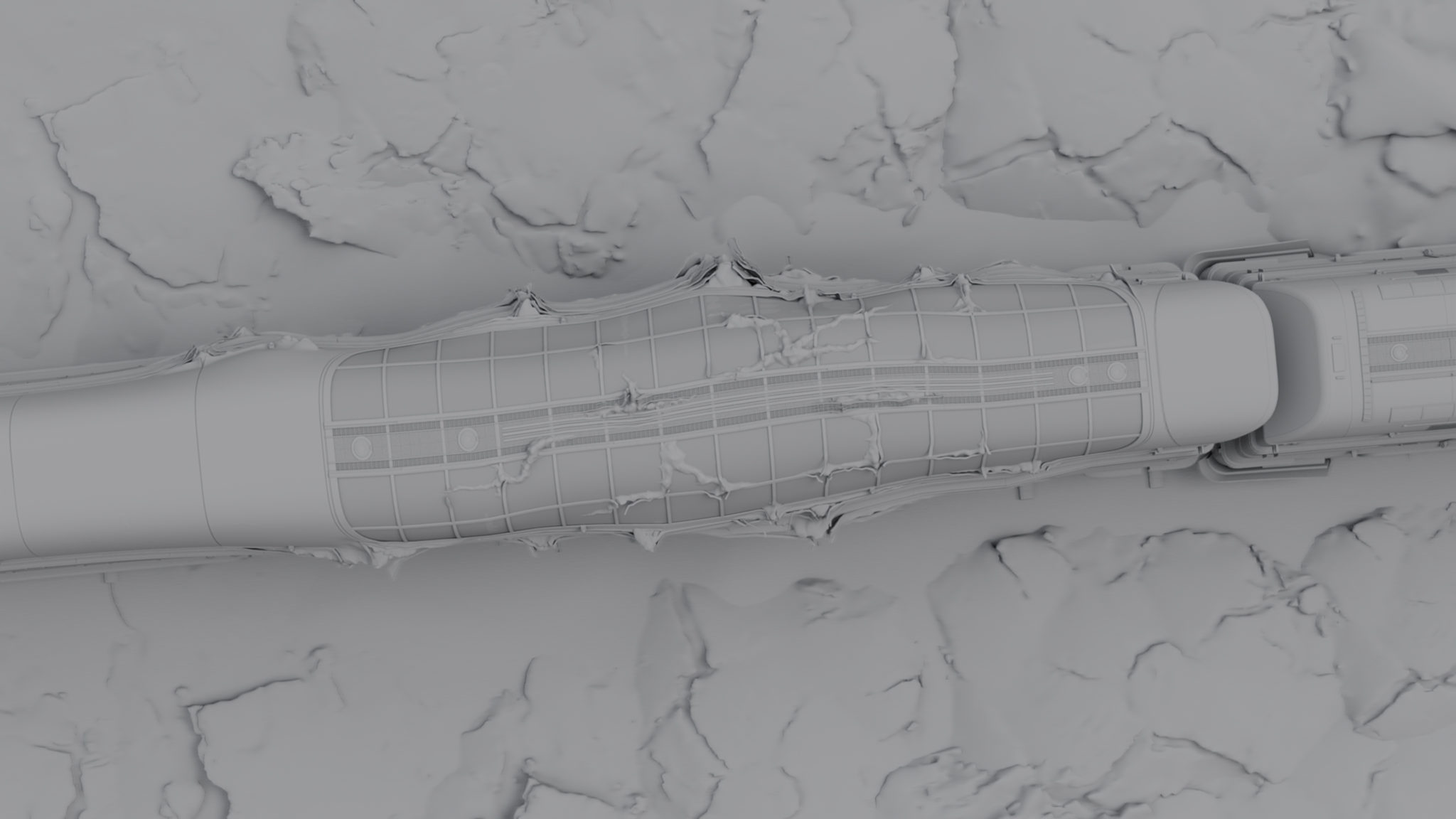
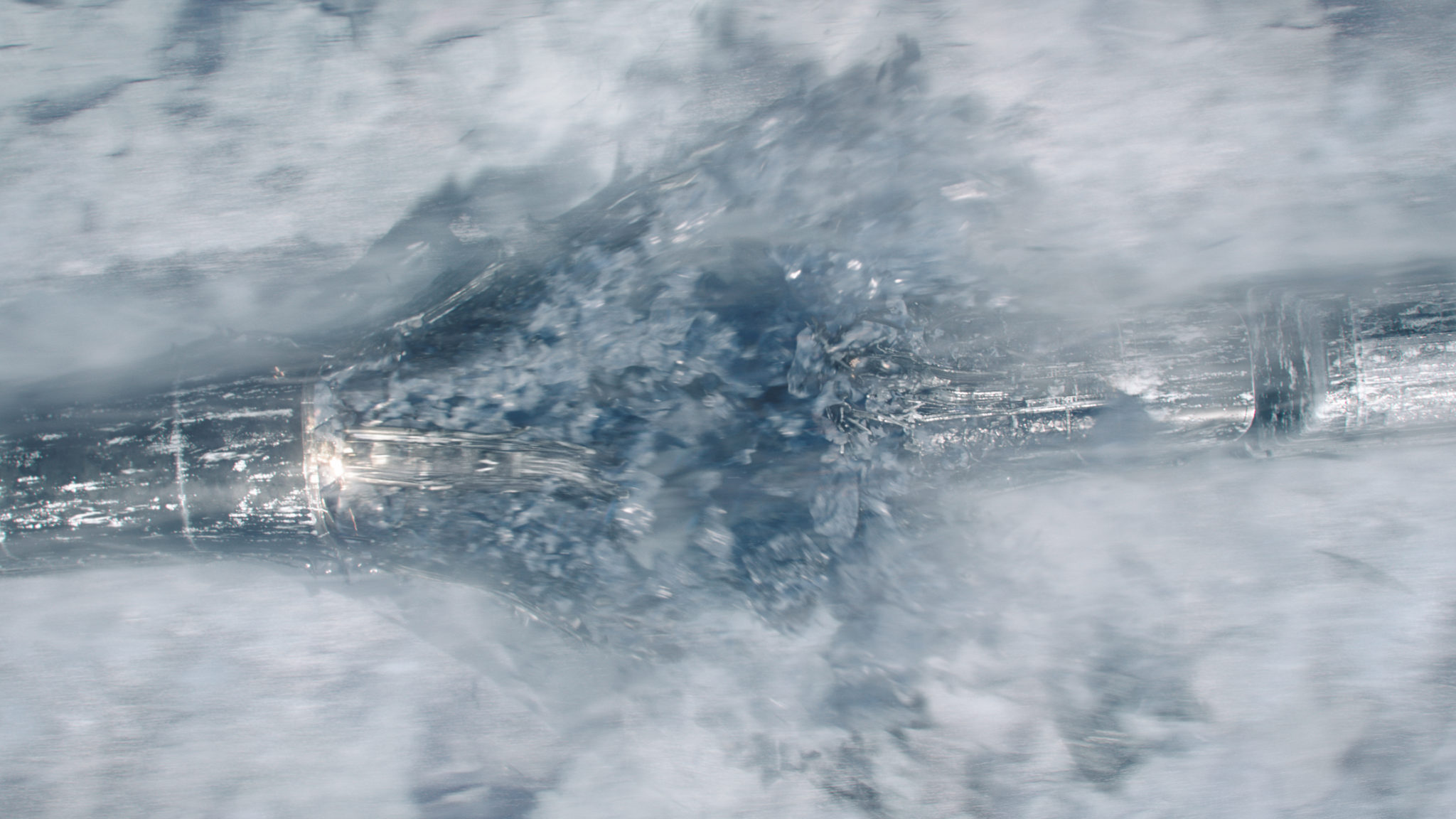
Deadly ice and complex FX
FX played a significant role across all seasons of Image Engine’s work on Snowpiercer. And as with the train, Hannes identified early on that new tools would be required to manage the FX shots quickly and efficiently.
“FX work was in almost every shot, from bigger effects to smaller, more subtle details, like the snow kick-up from the train, snowflakes, and atmos and fog,” says Hannes. “On season two, we knew we had to make these shots an almost automated process, as doing this work repeatedly for every shot in FX would be time-consuming and challenging to iterate.
“We decided to handle most of the atmospheric FX tasks in comp and improved our tool and system in Nuke to do so. Doing things this way did add extra comp work that required rendering deep passes and caching, but ultimately, it was way faster than the alternative and gave our compositing team a lot of control over the final look without having to wait for new FX and lighting renders. The team had a lot of scope for fast turnaround and art directability. In the end 98% of all falling snow, fog, snow drifts and cloud-like elements were done by the comp team.”
Image Enigne’s optimized FX system came in handy on one of Image Engine’s most memorable shots in Snowpiercer season, involving a full CG aquarium with plants and aquatic life…and its subsequent destruction. In a spectacular sequence, Josie (Katie McGuinness) separates the Snowpiercer train by breaching the aquarium car. This action causes tendrils of ice – also known as brinicles – to penetrate the aquarium’s water.
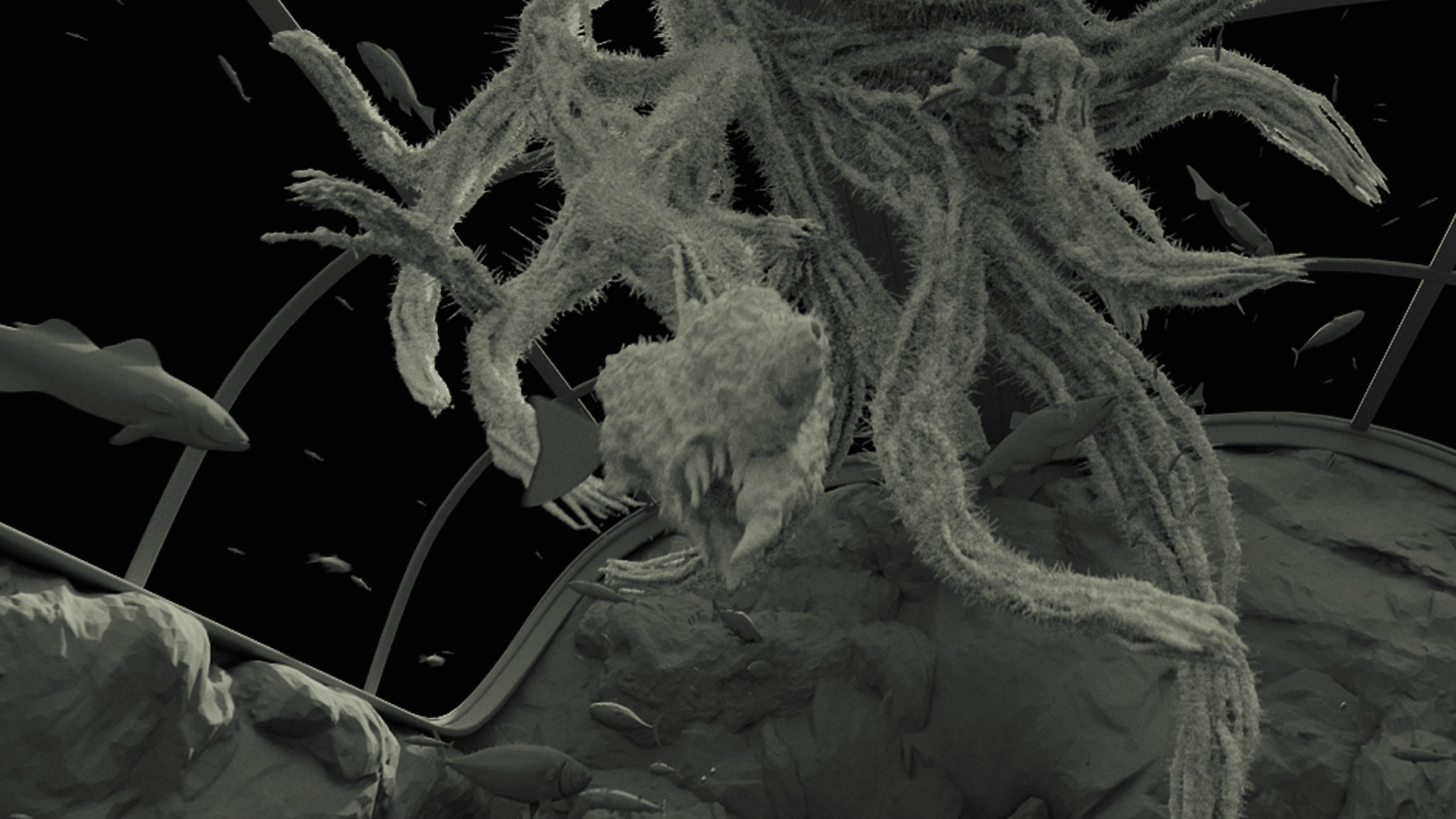

“The brinicles freeze fish and expand throughout the aquarium, ultimately freezing it entirely and bursting the whole train car due to the pressure,” says Hannes. “This full-CG shot required a lot of departments to work closely: assets created all the detail and specific damage stages, layout and animation timed key events, and FX developed a system for animators to establish the growing and forking brinicles, including an interactive preview for client review. Those animated keyframes drove the simulation and would then add icy spikes and surface expansion to let the freezing spread inside the water, flash-freezing fish and other animals in place.”
Hannes explains that the brinicle and ripping open of the outer shell of the train were based on asset work and hand animation, with FX simulation added after. “The animated fish and simulated plant movements were cached and could be offset and retimed quickly without new simulations. This approach gave us a lot of artistic control and allowed us to establish precise timing before simulating the heavy FX. A lot of utility passes were required so comp could control every aspect of the aquarium and FX and make the shot as stunning as it needed to be, given its pivotal importance in the season’s overall narrative.”
Refining the rails
Snowpiercer‘s gripping third season dropped on TNT in 2022. In season three, the stakes for Earth’s survivors are higher than ever. With the introduction of more advanced technology, surprising revelations about the state of the world, and the continued struggle for power, the Snowpiercer and Big Alice communities must confront their past mistakes while trying to navigate an uncertain future.
The new developments in Snowpiercer’s storyline required even more detailed visual effects; the more complex the plot, the greater the demand for Image Engine’s expertise in creating a visually cohesive and believable world. But this time, Image Engine was no longer a newcomer to Snowpiercer’s world; the team knew what they needed to do to deliver high-quality visuals without sacrificing efficient production.
For the Snowpiercer train itself, season three saw Image Engine push the envelope even further, as Hannes explains. “We reworked all the existing train car assets and added new cars where needed, like the library, observatory car, track scaler, crane car and EMP bomb car. We also updated and balanced lookdev for all train cars for consistency in lighting and comp layers, improved the lighting and layout system to handle a variety of shot work, and made a hero version for the Engine Car and Big Alice, as we had closeup exterior cockpit shots of those cars for the stand-off sequence in episode 3. We also added more complex interiors to all train cars for night shots, making the windows look more realistic at night, and created a whole new vehicle, the Track Scaler – a small autonomous track vehicle. This was a ton of work, but as always, the team tackled it all with a high degree of professionalism, experience, and talent. Our crew did so much great work on the train in such a short period.”
“We were constantly thinking about new approaches to achieving the shots we had to deliver and made a lot of enhancements and improvements to our workflow to do so,” adds Cameron Widen, Image Engine’s Head of Layout. “The train track tool, for example, played a big role in streamlining setups compared to season two. We optimized the tool to make it easier for the layout team to iterate on shots – they could change the track, swap car types, and add train placement interactively, even when the environment and ground under the train changed.”
Crafting dystopia: Building digital environments
In addition to the detailed work carried out on the train, Image Engine also dedicated considerable time and effort to creating a swathe of digital environments across Snowpiercer season three. Image Engine’s artists created multiple environments, including a ruined city covered in snow and an abandoned trainyard.
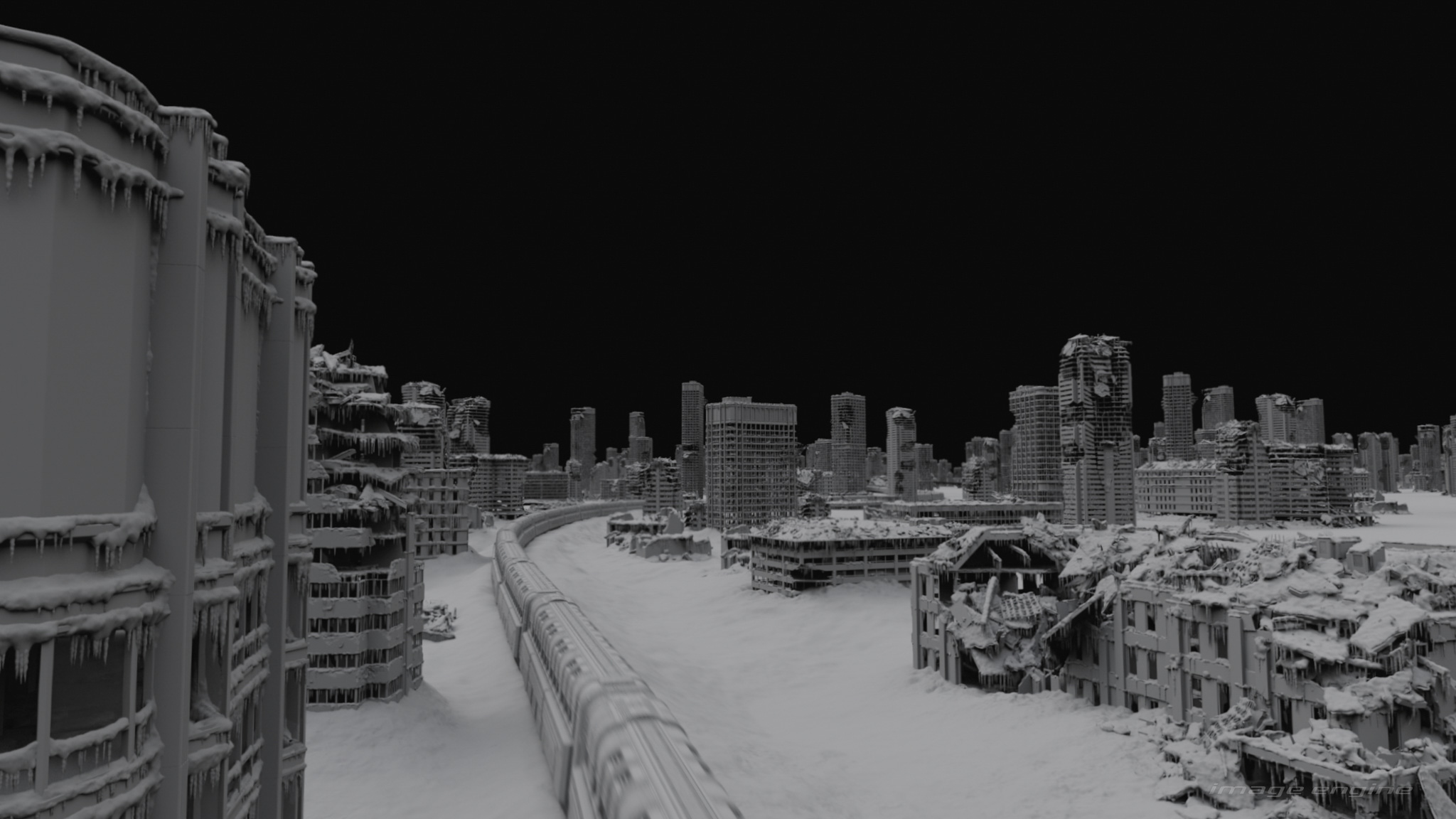
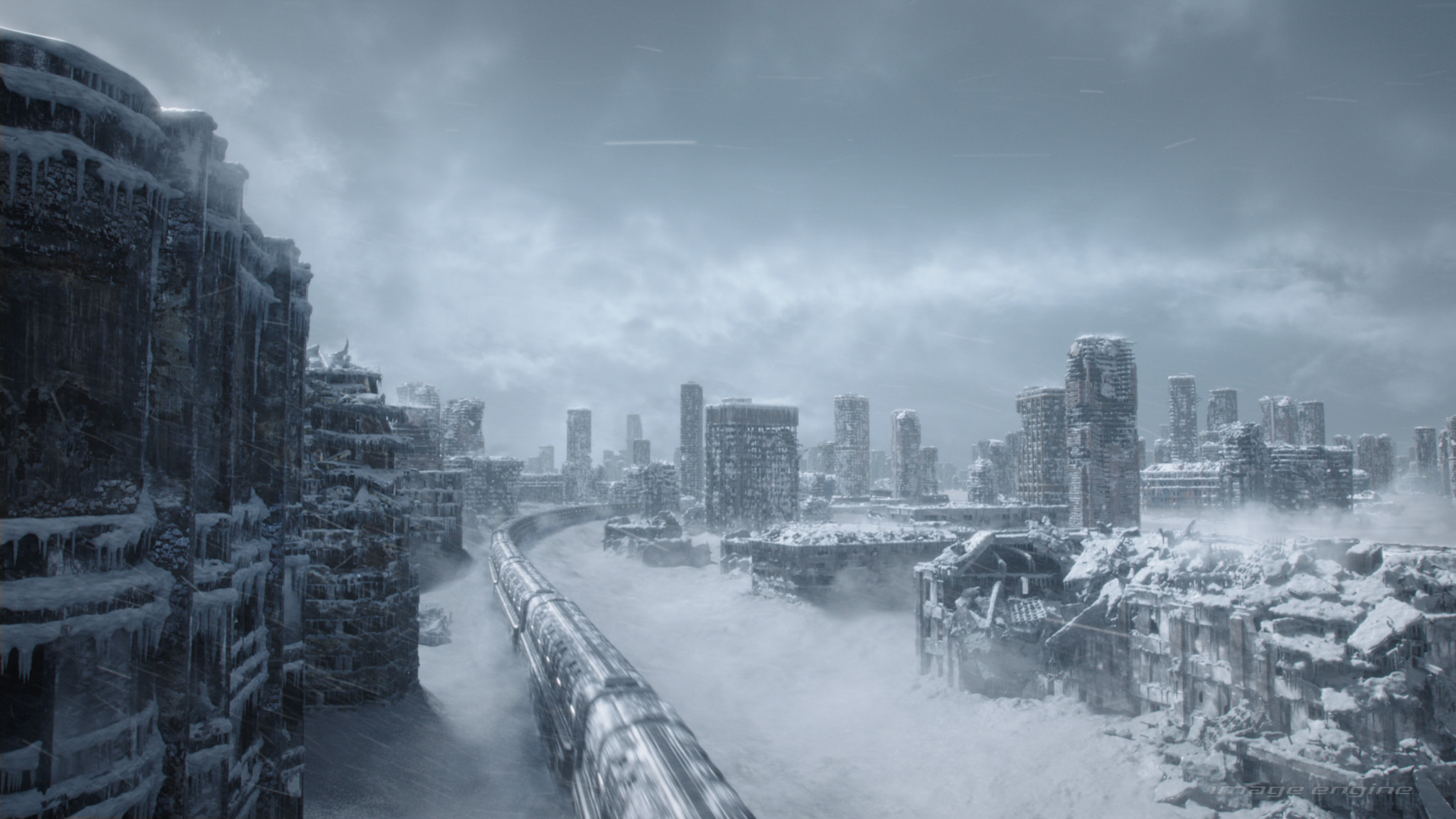
When creating these settings, Image Engine needed to constantly keep track of the train position and the angle viewers had on the environment based on the story’s progress, as Hannes explains. “For both of these settings, we built the whole environment for rough layout and shot establishment, then refined and added details in all the areas that would be most visible to audiences in each shot. This kept us efficient while still giving the team scope to create an immersive and detailed world that would hook the viewer.”
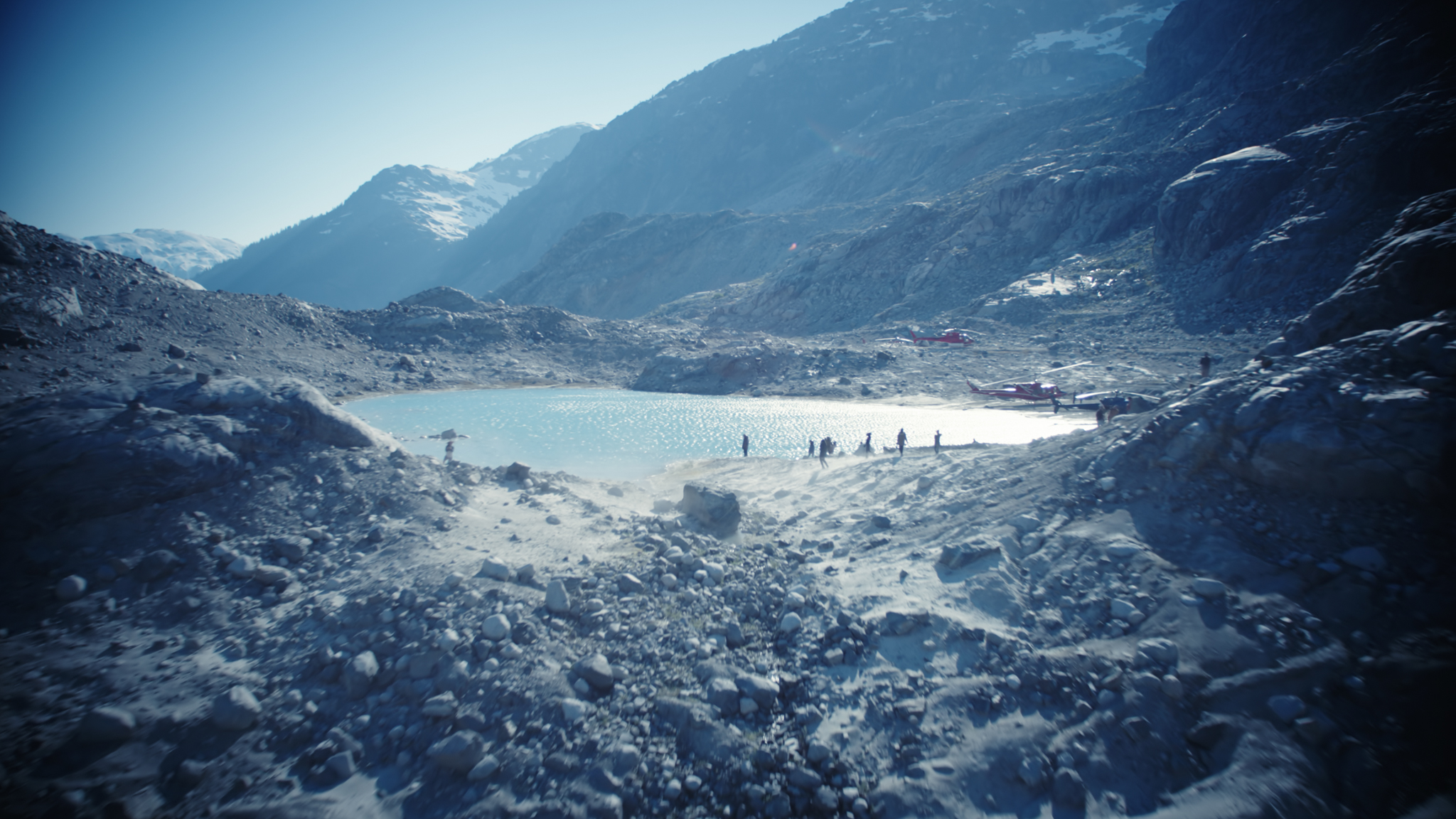
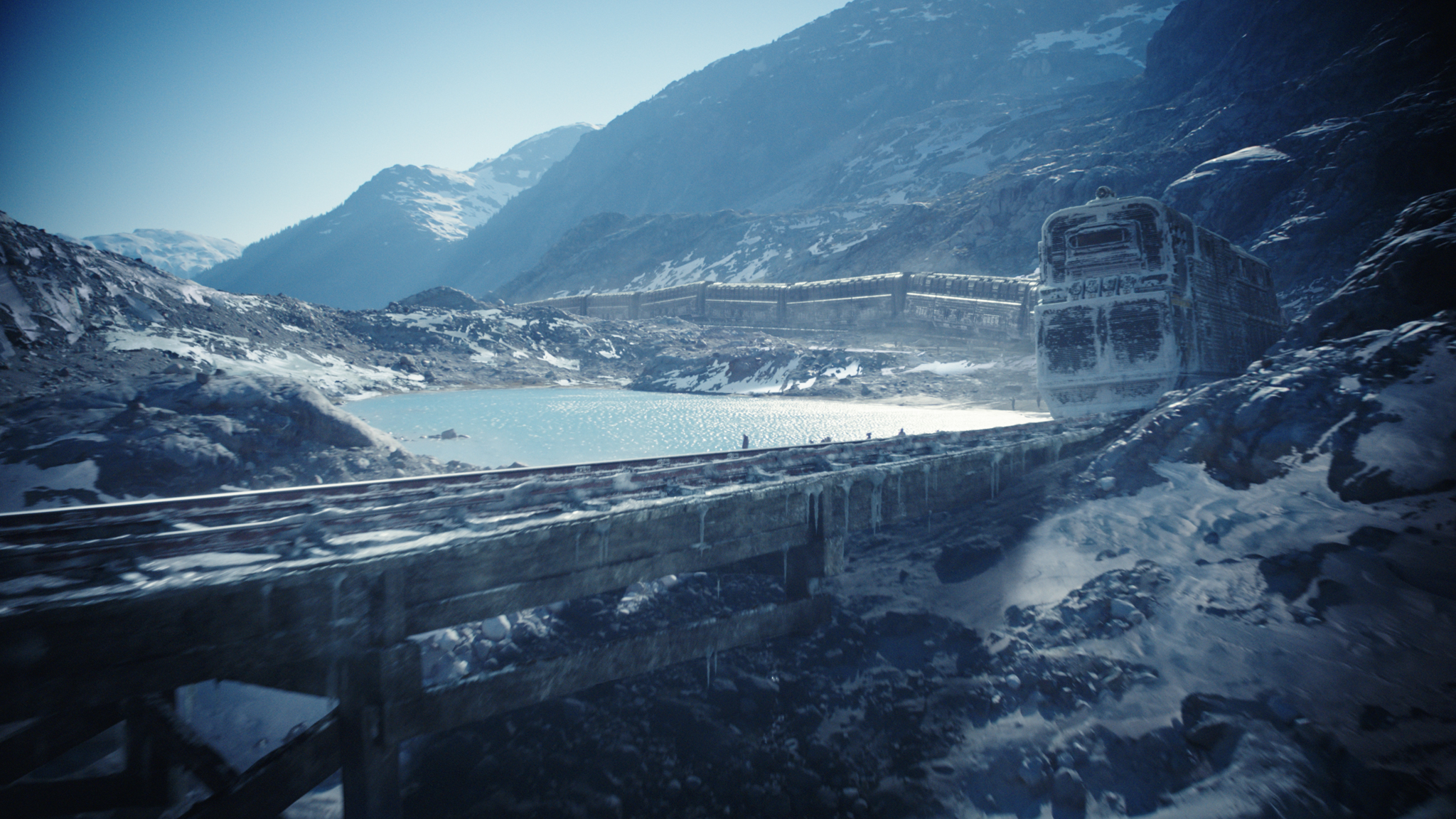
Image Engine used Unreal Engine to create Snowpiercer’s simpler environments but turned to traditional, non-real-time workflows for the more complex settings. “These environments required different presets and workflows in lighting and comp to accommodate output from Unreal/Arnold/Nuke,” says Hannes. “We developed a new tool and optimized comp presets to handle huge amounts of heavy atmos and particle work in Nuke, which helped to sell the photorealism of these environments.”
Chaos on rails
As with Snowpiercer season two, season three also required a host of exciting FX and destruction sequences. From burning trees to collapsing bridges, Image Engine’s team blended multiple visually stunning moments into the show’s narrative via the power of FX.
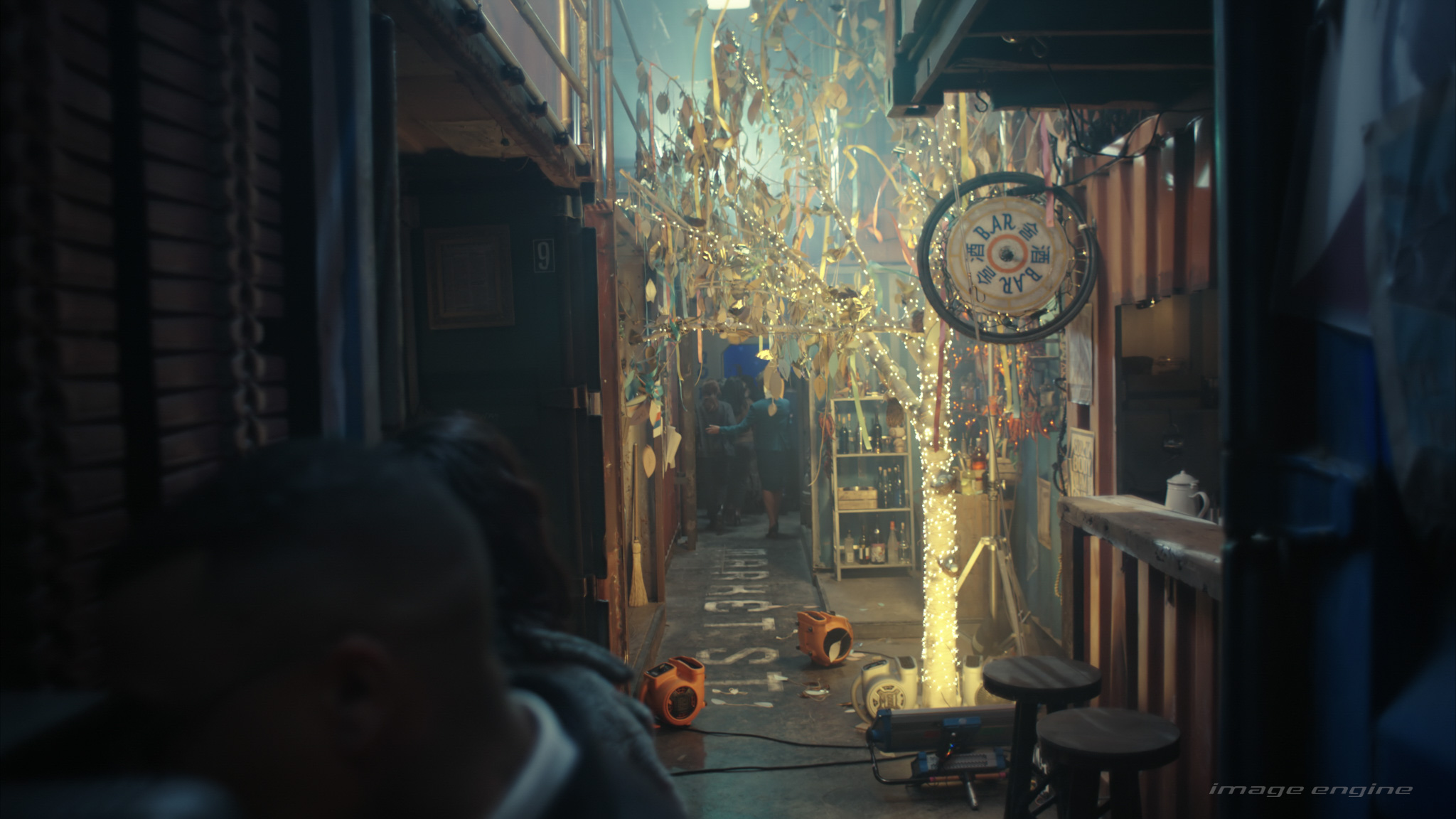
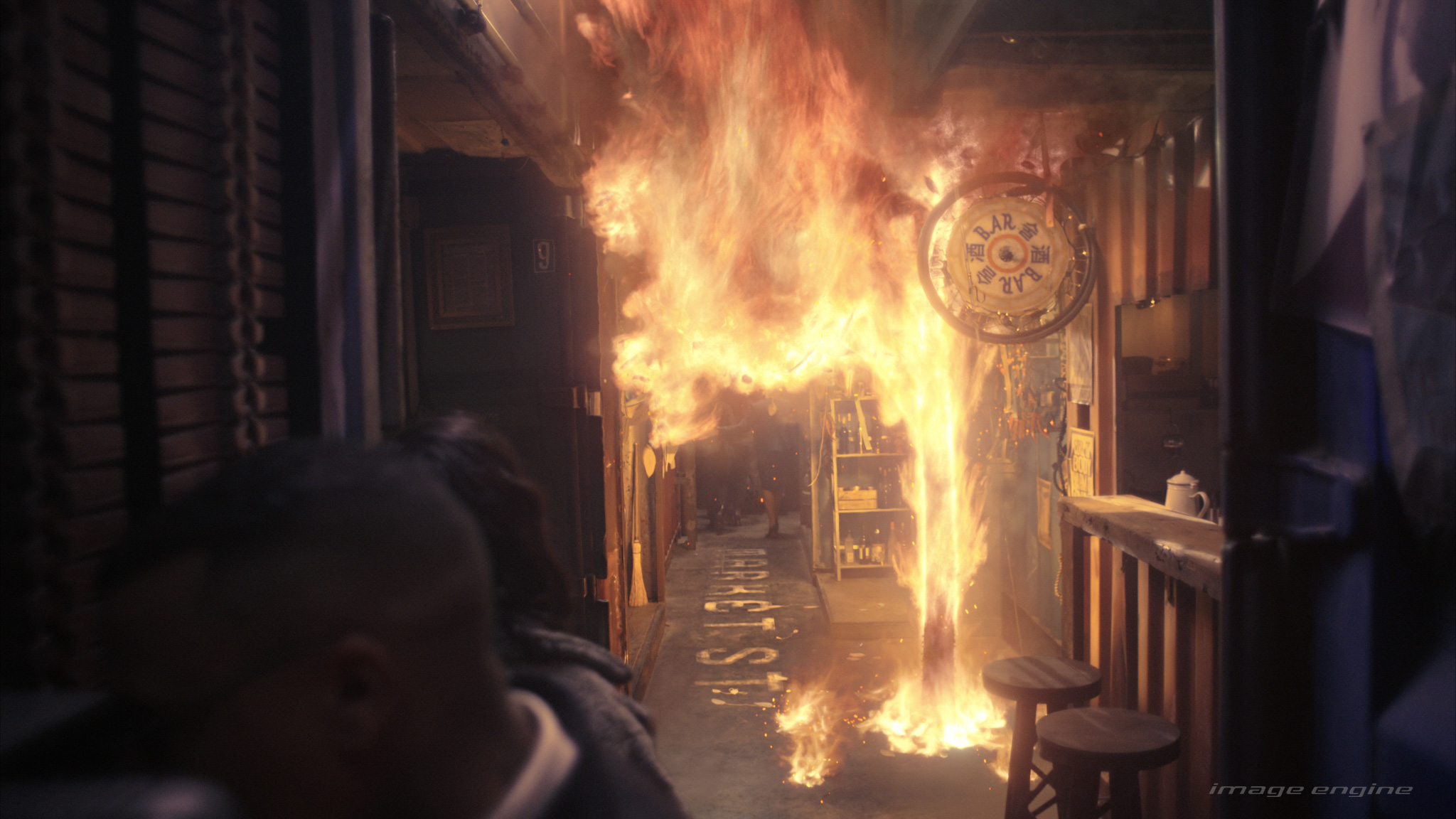
“A lot of our work on season three involved destruction effects, explosions, and fire,” says Hannes. “For example, the shot of the burning tree ended up as a full CG replacement; it required multiple simulations of paper leaves hanging on strings and reacting to the draft created by the fire, which we also created in FX. We also rigged the tree so we could position the branches to match the plate footage wherever required.”
One of season three’s most destructive moments sees an old trestle bridge partially collapse under Snowpiercer’s weight, causing some of the train cars to derail. “These bridge destruction shots were some of the more challenging FX shots in season three,” says Casey Yahnke, Lead Compositor at Image Engine. “We had to sell the environment’s scale through visible depth queuing while maintaining details and the intensity of the storm – it was a fine balancing act. For the destruction, we built the bridge in sections to simulate partial collapse and breaking of timbers. We also added FX like snow being shaken from the bridge by vibrations.”
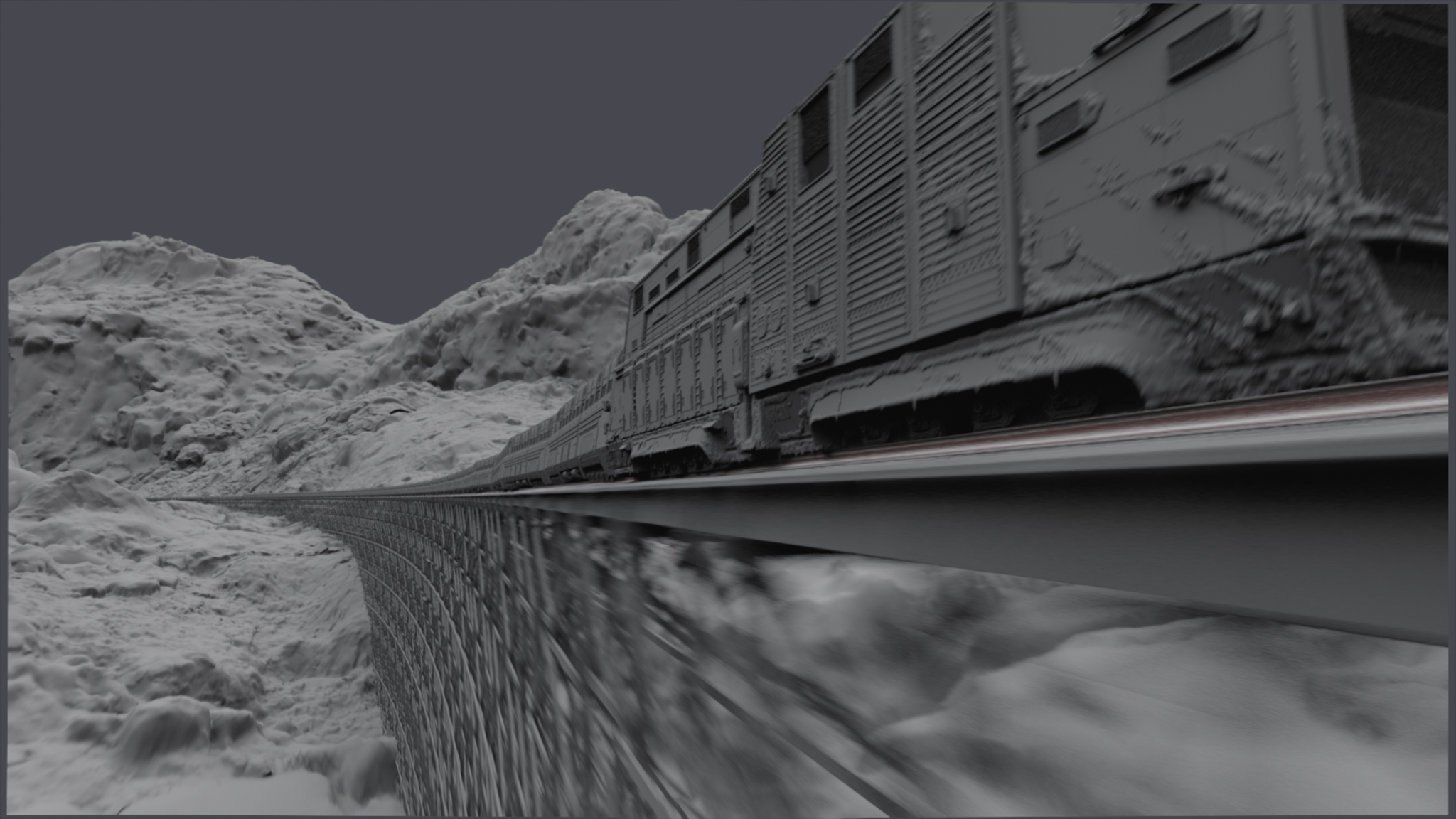
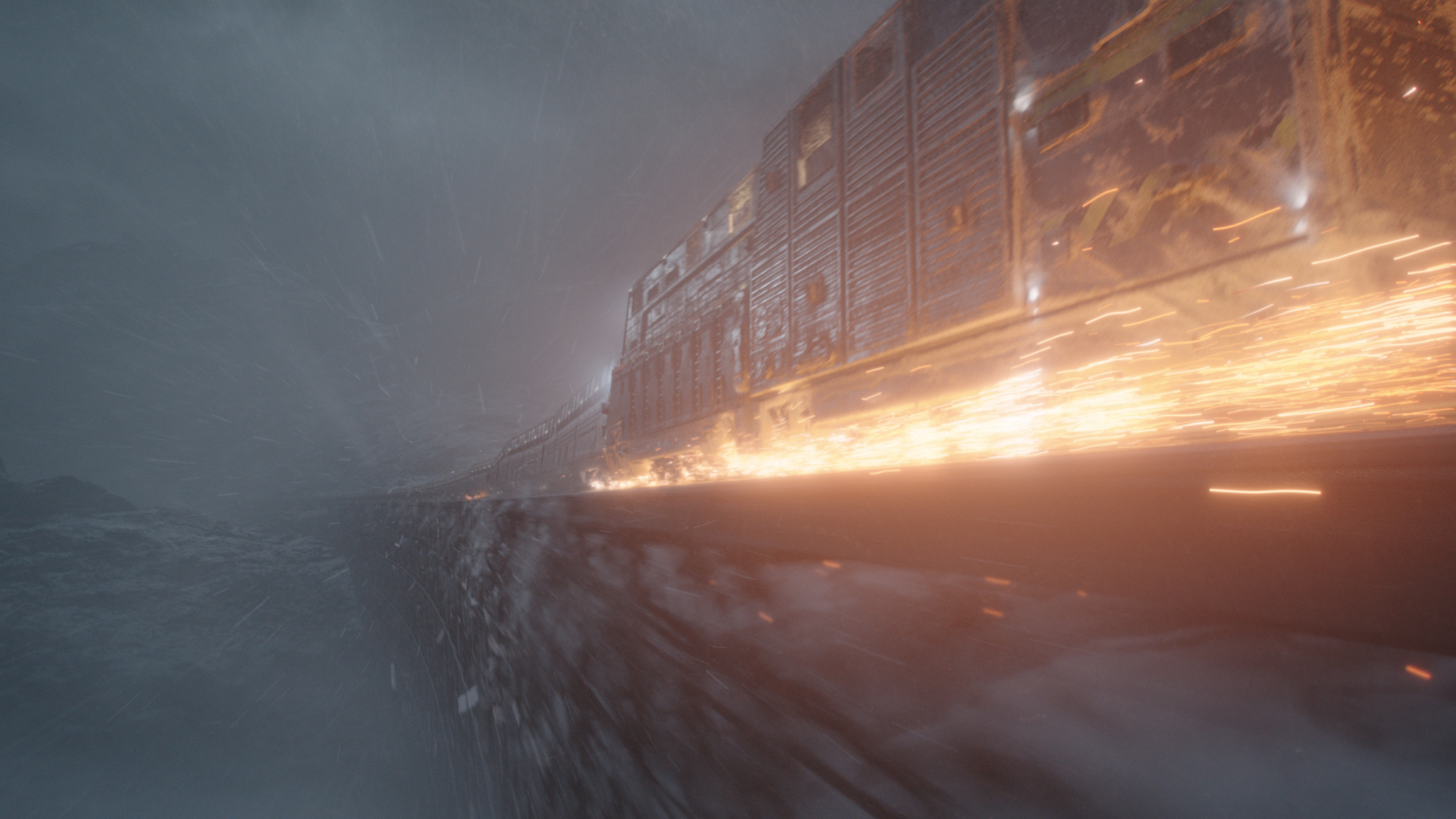
Another high-stakes scene in season three sees Snowpiercer attacked by a giant harpoon. Following the attack, the train’s engine explodes and starts a fire, causing Snowpiercer to derail and slide along the track. “The derailing was mostly hand-animated,” says Hannes. “We modelled different damage levels for the train and added larger debris pieces by hand alongside sparks, fire, snow interaction, and additional smaller debris from the FX department.”
Ultimately, it was a combination of cross-departmental efforts that brought life to these intense scenes, but Casey attributes a good portion of the success to the FX team’s contribution. “We owe a huge debt of gratitude to our FX folks for these shots,” he says. “The team delivered many complicated destruction effects; the amount of work that went into them was super impressive. Everything felt like every element belonged in the frame.”
Visualizing the void
Snowpiercer season four hit screens in 2023. In it, the show’s post-apocalyptic narrative reaches new heights of intrigue as Snowpiercer explores areas previously thought to be uninhabitable, including one scene where the train leaves its tracks and travels independently across a frozen ocean. The season also involves more action and expansive environments, meaning Image Engine was trusted with 343 shots across multiple episodes. Notable sequences included the Snowpiercer train metamorphosing into a snow tread vehicle, unveiling an epic frozen port city, a thrilling nighttime rocket launch over an icy ocean at night, and the dramatic freezing of the character Ben (Iddo Goldberg), who makes a supreme sacrifice for the safety of others.
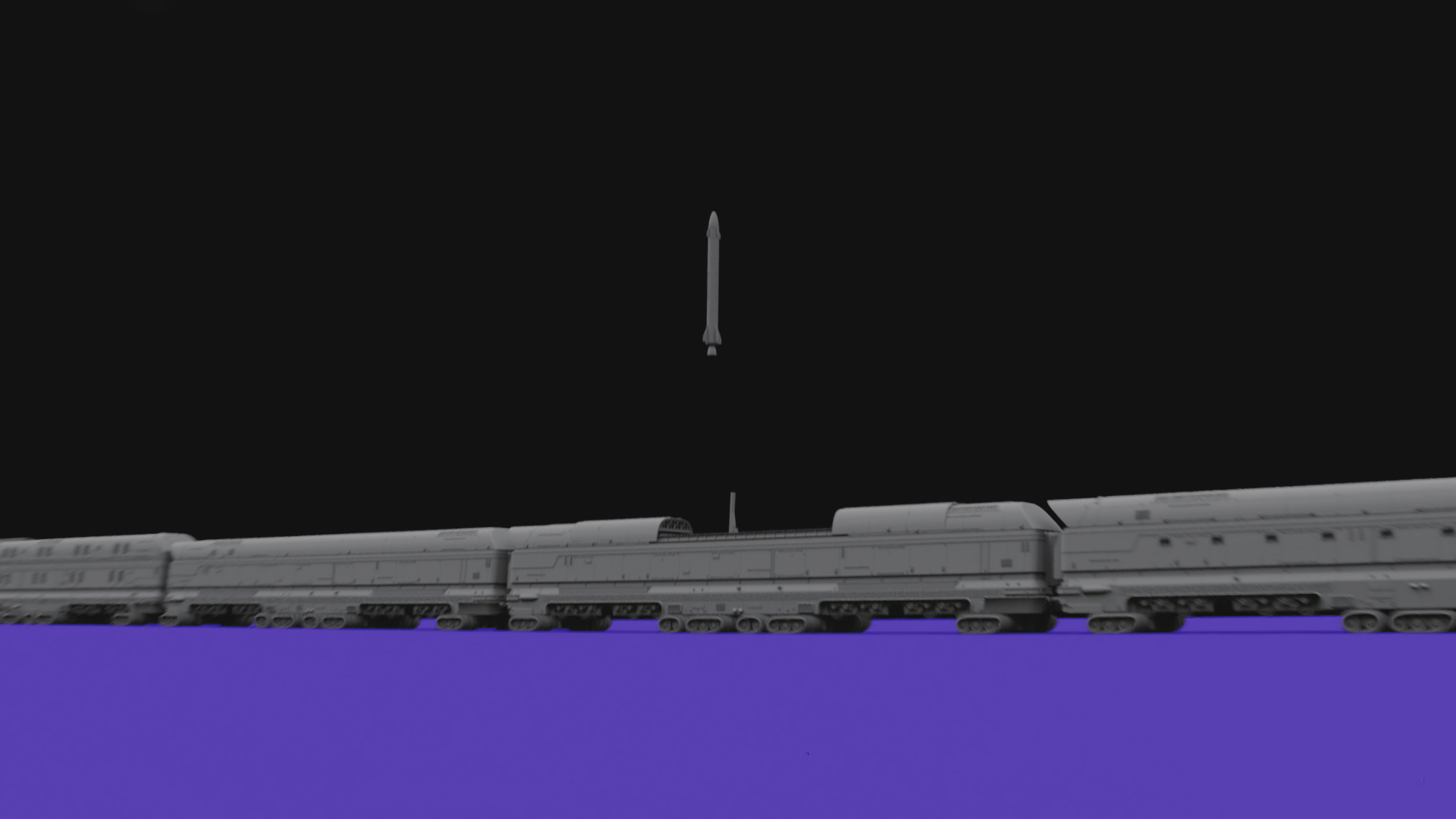
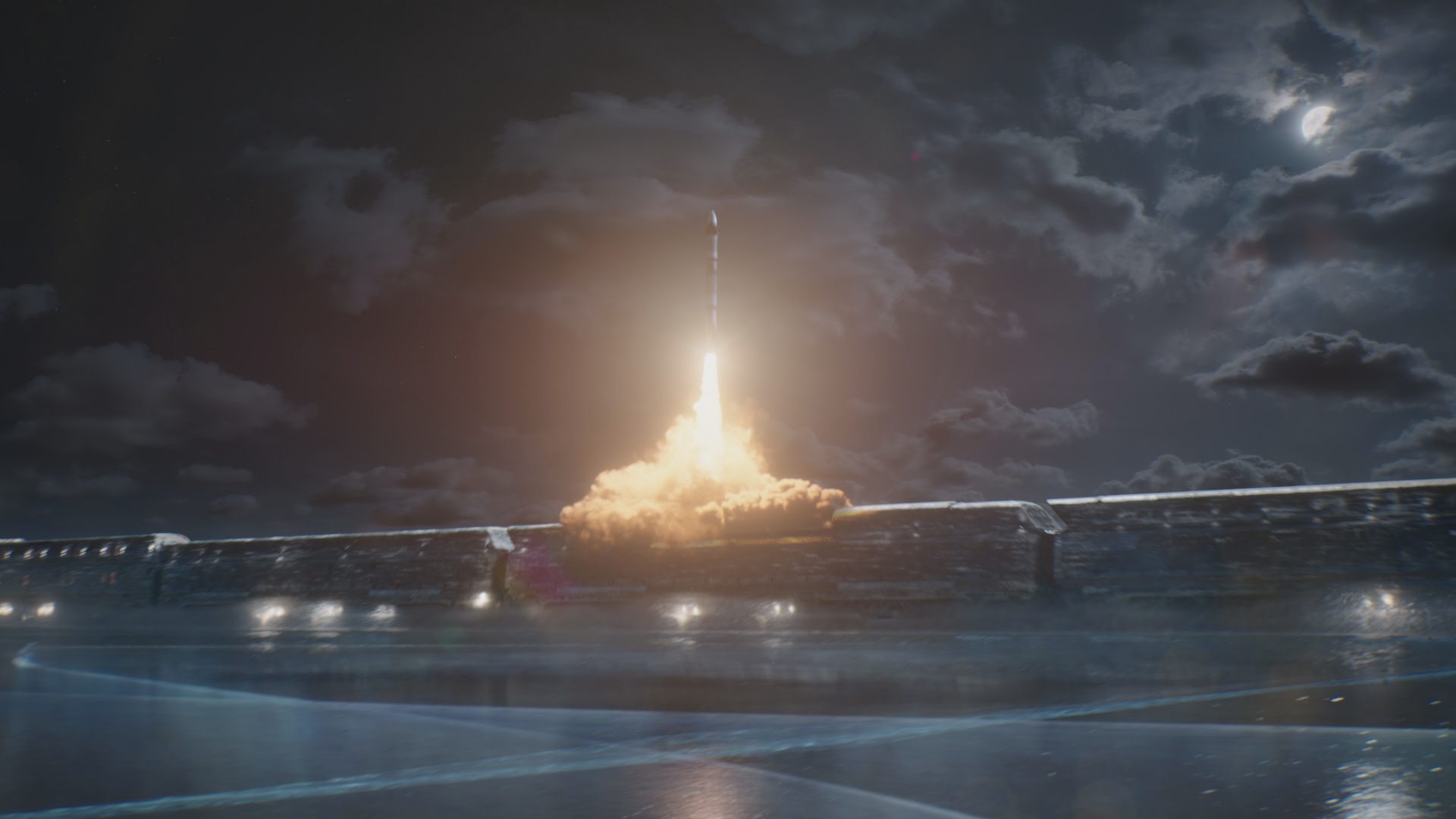
“The amount of work on season four was fivefold, so there was a big difference in volume and the size of the comp team,” says Jesus Lavin, Compositing Supervisor. “Some of the more complex shots were those where we had to comp practical sets on huge, full-CG environments with long aerial travelling cameras. These shots were very challenging and required a lot of integration.”
One such environment was that of New Eden – a new warm spot discovered on the frozen Earth. Image Engine built the entire valley of New Eden, ensuring it looked convincing from multiple angles. “The New Eden environment shots contained multiple square kilometres of landscape with buildings, mountain ranges, lakes, and the integration of the trestle bridge and canyon from season 3,” says Hannes. “The environment team needed to work from many different angles in full CG, but with the added challenge of combining that with plates of the New Eden set.
“As well as the more expansive shots of New Eden, we also worked on close-up sequences of many areas that only make up a tiny part of the environment, which we up-rezzed and refined to accommodate the need,” he continues. “These shots included the bridge worksite, canyon, top of the cliff, and the area west of New Eden with its parked trains and tracks.”


In one episode, viewers witness the camera pan over the New Eden worksite, soar across the tundra, and fly by the track scaler vehicle.
“This shot started with a live plate component of a crane shot that was handed off to a 3D rendering of a fly-through animation,” says Jack Evans, CG Supervisor. “We blended the final shot in comp with added digital matte painting elements to fill out the background. Combining these disparate elements into one cohesive shot was challenging, but our compositing team knocked it out of the park. By the end of the show, these huge environment shots felt second nature.”
Ali Ehtemami, Lead Compositor at Image Engine, ensured the particle and FX setups that gave these environments an extra edge in fidelity continued to be refined and improved to ensure a realistic result.
“The number of shots, delivery targets and the fact that we were working on all the episodes across the season made season four even more challenging – and every shot was embellished with snow particles and 2D atmos and fog elements,” says Ali. “So, to meet this challenge, I took all the great FX work the team accomplished on Snowpiercer’s previous two seasons and further refined and optimized the core atmos and particle tool we created for smoke, snow, snowdrifts, clouds, and fog in Nuke. I tweaked the setup in a way that kept the quality of the particle setups high while running at least ten times faster. Moreover, we introduced a new modular compositing workflow specifically tailored for this show, coupled with various optimizations implemented in the compositing process. These advancements greatly contributed to enhancing production efficiency!”
Embracing complexity
Of course, the Snowpiercer train itself did not go without its fair share of attention in season four. This time, the train’s visual effects required a significant increase in mechanical complexity as well as further optimization of the train track tool, as Hannes describes.
“For season four, the tool could: generate better wheel alignment and displacement and connect wheels correctly on the train track, even when the track was curved or sloped; correctly link the train cars; create better train car spacing with support for steep angles and curves; and improve instancing for performance and caching,” he says. “By this point, the tool was firing on all cylinders and saving us time which the team could then spend on creating even more beautiful, believable shots.”
Those shots included some close-ups of Snowpiercer that revealed the train in more detail than in any previous season. One close-up sequence sees the character of Ben stepping outside the train to release a stuck link between two train cars, and in another, Melanie (Jennifer Connelly) must crawl through the train’s undercarriage and into the cooling vents. For these scenes, the Image Engine team had to construct the Snowpiercer’s intricate undercarriage with numerous moving mechanical pieces and higher-resolution textures.
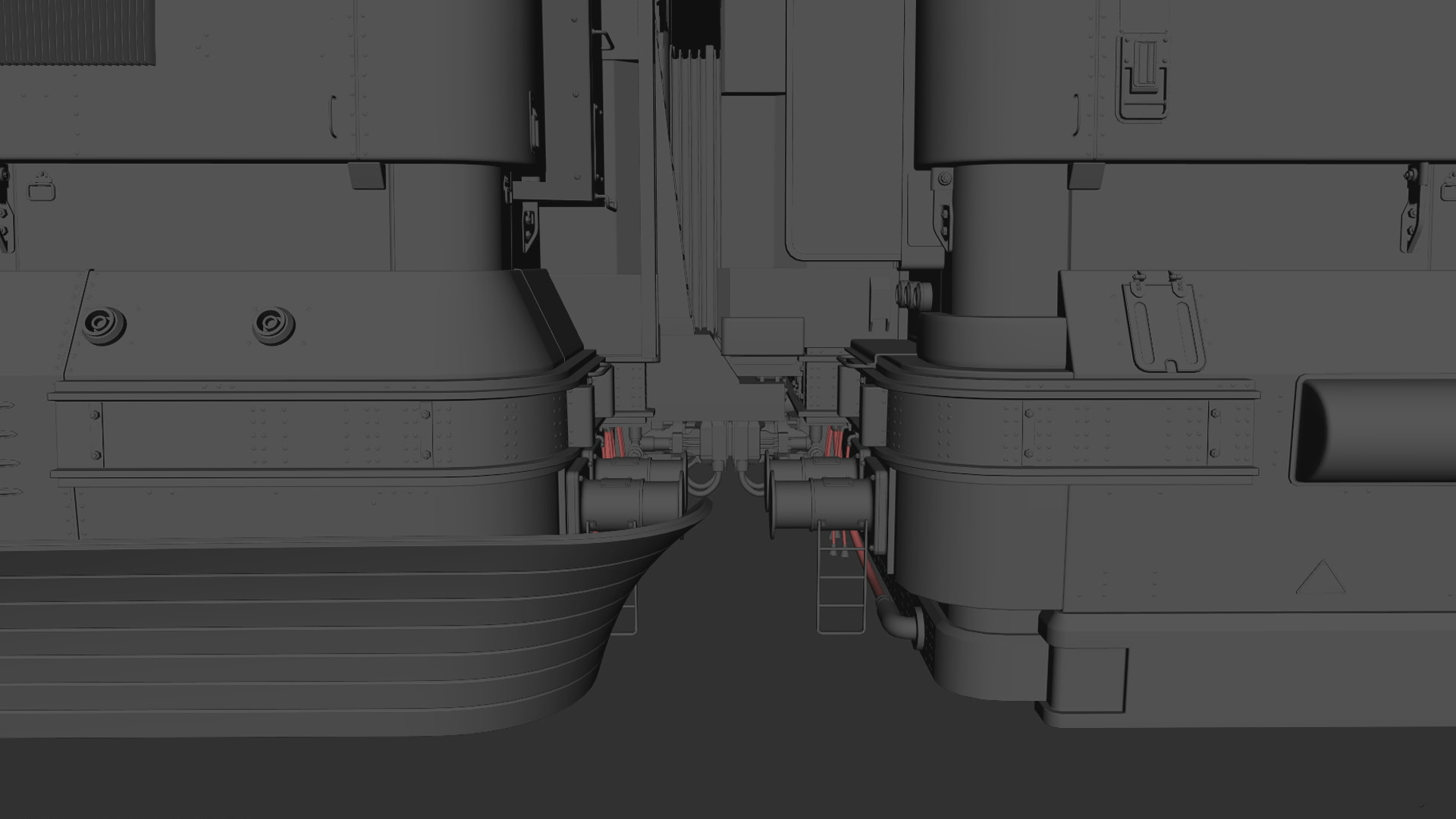
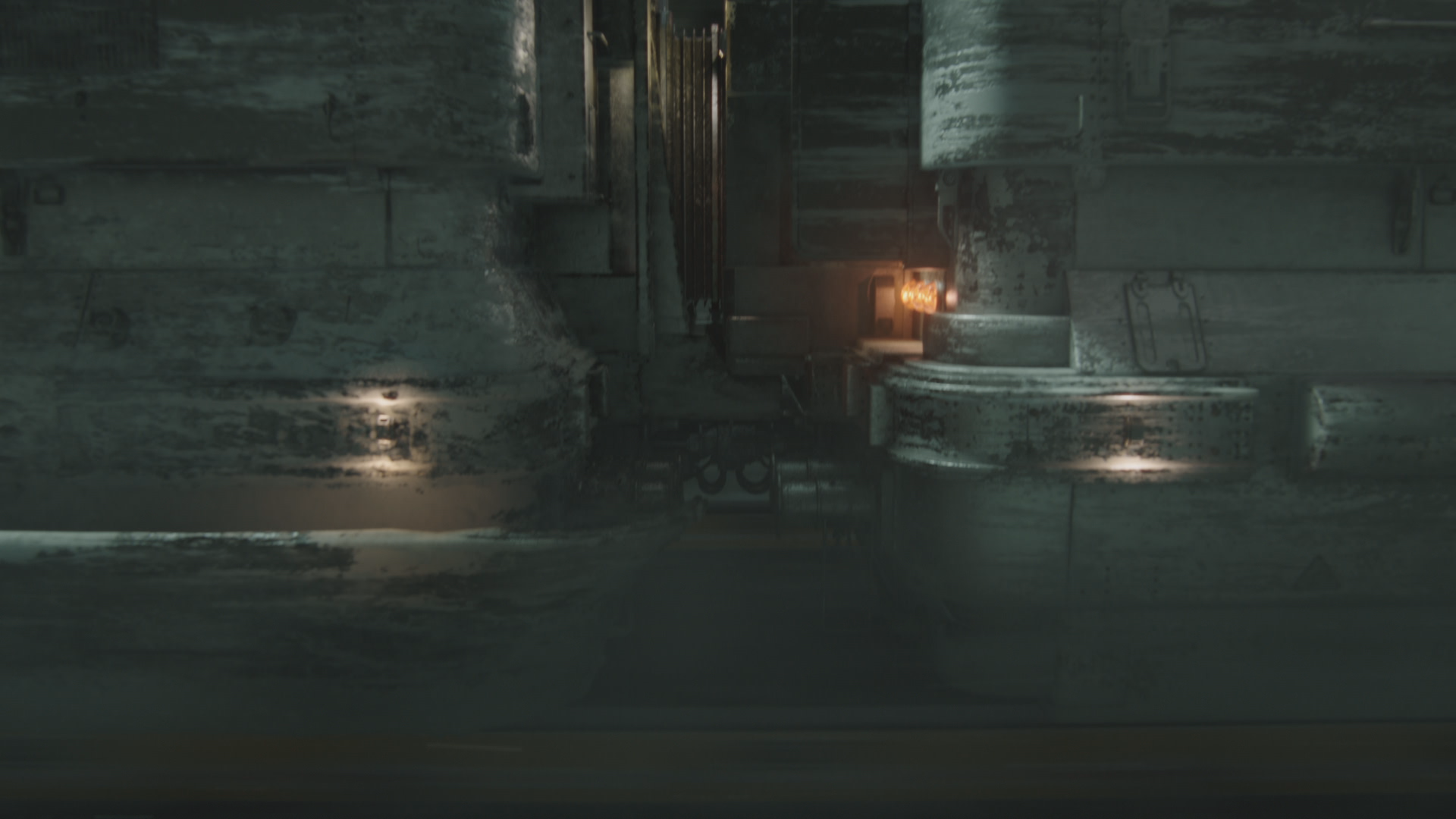
“The most challenging setup was definitely the close-up shot of the undercarriage of the train where the tank-like treads are first revealed, which enable Snowpiercer to leave the tracks and travel independently across the frozen ocean,” says Jack. “The team had to design a believable system that could deploy snow treads across the whole train, lift it with hydraulic pistons and allow Snowpiercer to leave the track and freely drive through a ruined port city and onto a frozen ocean.”
To create the sequence, Image Engine created concept artwork of the undercarriage design for approval, then built out the treads and their animation, ensuring the mechanism felt like something that could realistically propel the train. “Our animation supervisor, Curtis Richardson-Smith, created animated mockups of modified geometry for the mechanism used to link the cars together, which the asset department then used to build out the more detailed work,” explains Jack. “Ultimately, the close-up shot revealing all of this was a cross-department effort involving assets, animation, FX, and compositing. When it all came together, the results blew me away.”
Making the unreal, real
Image Engine’s task list for season four also encompassed numerous shots of actors against a green screen, such as some scenes that show characters moving around on the exterior of the Snowpiercer train.
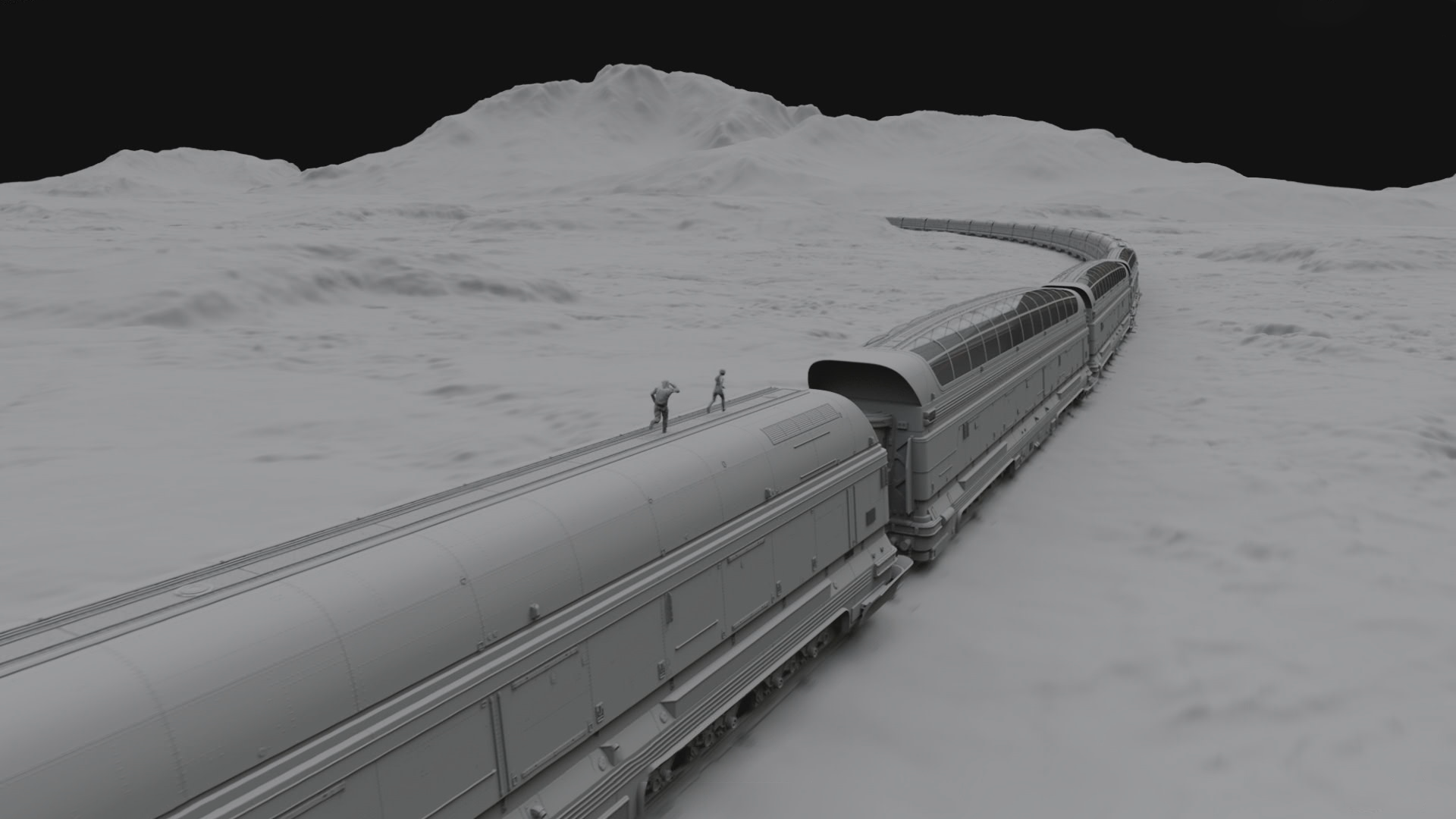
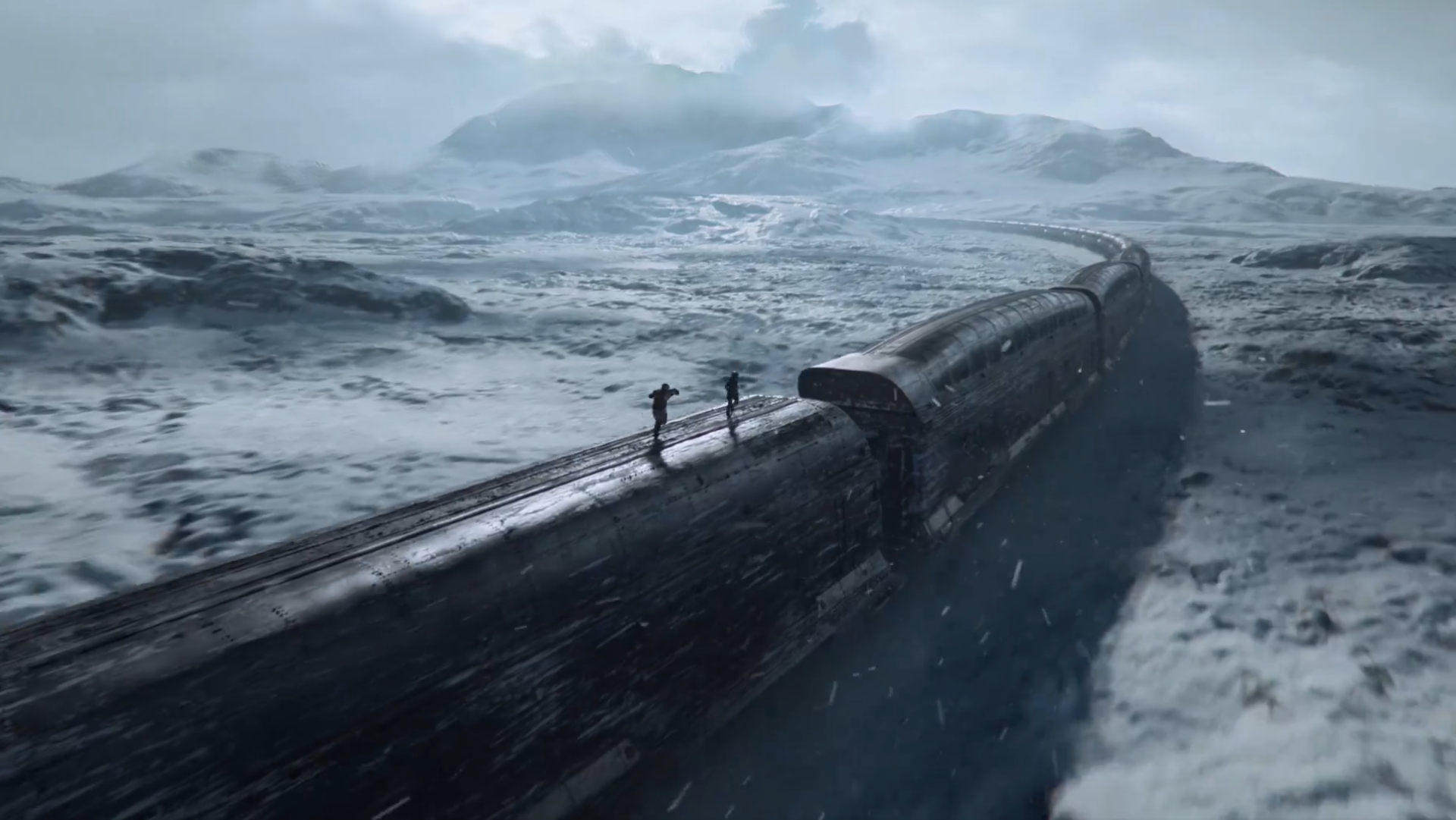
“The biggest challenge on shots like these is always integrating something shot on stage to make it look like the actors are actually on a train driving 150kph and rumbling through a frozen world,” says Hannes. “This is an even bigger challenge when the actors are very close to the surface or touch and interact with the CG train, like Melanie hanging onto the ladder on the side of Snowpiercer. There are an incredible amount of details and small things to get right, or else the shot will look fake. These sequences require flawless execution from matchmove and roto to lighting and final comp.”
Jesus adds: “When dealing with blue screen material shot on set, the challenge is finding a middle ground between the look that comes with studio lighting and the lighting you need in your CG to make the shot look good. Nevertheless, our Image Engine lighters are amazing at tasks like these at this point.”
Image Engine also updated and optimized its tools to more easily incorporate 2D elements on cards within its 3D scenes. “These updates gave us a lot of flexibility in quickly trying out different ideas without involving the compositing team every time we wanted to combine practical elements in our CG environments,” says Widen.
Many scenes across Snowpiercer season four also required the addition of digital doubles – CG replicas that needed to feel as believable and natural as their living counterparts to sell the believability of the set pieces in which they featured. “When you have a full CG shot with digi-doubles, most of the workload is on the shoulders of animators and lighters,” says Jesus. “Again, at this point, the team is fantastic at making these shots feel real. Our artists delivered some incredible work.”
Creative synergy
On any project, building a strong creative relationship between visual effects and production is critical to the creation of great-looking visuals. On Snowpiercer, that bond was particularly strong, with a robust level of understanding and mutual appreciation that ensured the Image Engine team was well-equipped to deliver great work, even on short deadlines.
“Our relationship with the production on Snowpiercer across all seasons was amazing – we worked with the production team, not for them,” says Hannes. “The Snowpiercer production had a lot of experience with and a deep understanding of the complexity of work in visual effects. As such, there was a significant amount of honesty and transparency about what production expected from the visual effects, what challenges were present and required solutions, and what desired intentions or results we needed to consider.
“Even when bigger notes or changes came through late in the game, which can happen after an early screening, the production came to us with respect and awareness and ensured we were always prepared before something became a problem. The Snowpiercer team would not only clearly explain what needed to be changed and why but would also ask about our options and how the changes would affect overall resources and time frame. We could collaborate on solutions, ensuring both sides were clear about the goal and the path we needed to take. The process made allocating resources like tools, methods and crewing to the right places easy, and that in turn kept us on track to hit deadlines.”
Another distinctive characteristic of the relationship was the creative and open-ended nature of the notes Image Engine received from the production team. These notes were often interpretive rather than prescriptive, giving Image Engine flexibility to find solutions that looked great on screen, as Hannes explains.
“For example, instead of asking for specificity, like, ‘Increase Explosion A’s size by 20 percent and its speed by 30 percent,’ the production would say, ‘Make the explosion more dangerous and impactful – the viewer should feel like this character is threatened,’ and they trusted us to find the right solutions to that. We were not constrained to precise notes and direction; we had the flexibility to apply Image Engine’s experience and expertise to shots. The freedom this feedback offered made the creative process and execution more fun and rewarding for our artists, and in my opinion, increased the quality of what we delivered.”
A long-haul project
Working on the visual effects of a series like Snowpiercer does not come without its challenges. Nevertheless, over the last three seasons, Image Engine met each problem head-on with experience and expertise, optimizing processes and refining workflows over time while staying agile enough to adapt to new challenges.
“There are advantages and disadvantages to working on projects like Snowpiercer over such a long time,” considers Hannes. “You can establish workflows, but sometimes, a small deviation from the usual scope can require bigger changes to your standard pipeline, so you must always evaluate one-off solutions versus adding features. Every season of Snowpiercer added new challenges and types of shots, so we had to stay nimble and think on our toes.”
Jesus concurs: “No job is a straight line. There are always challenges and new problems to solve – not to mention great art to make! Regardless, optimization, standardization, and the ability to think quickly on our feet helped the team to deliver a high amount of shots every week while saving people time to be more focused on the creative side of their tasks.”
And this is why Image Engine delivered Snowpiercer’s visual effects on time and at such high quality – they sit at the intersection of imagination, technical know-how, and experience – three skills that Image Engine brings to every production.
“As with any other project we work on, Image Engine’s primary goal on Snowpiercer was to make the work as easy as possible for the team, so they could focus as much of their energy as possible on making things beautiful instead of struggling to get the work done,” concludes Hannes. “The studio did an excellent job in this regard – the results speak for themselves on even the biggest and most challenging shots we completed across the three seasons.”


